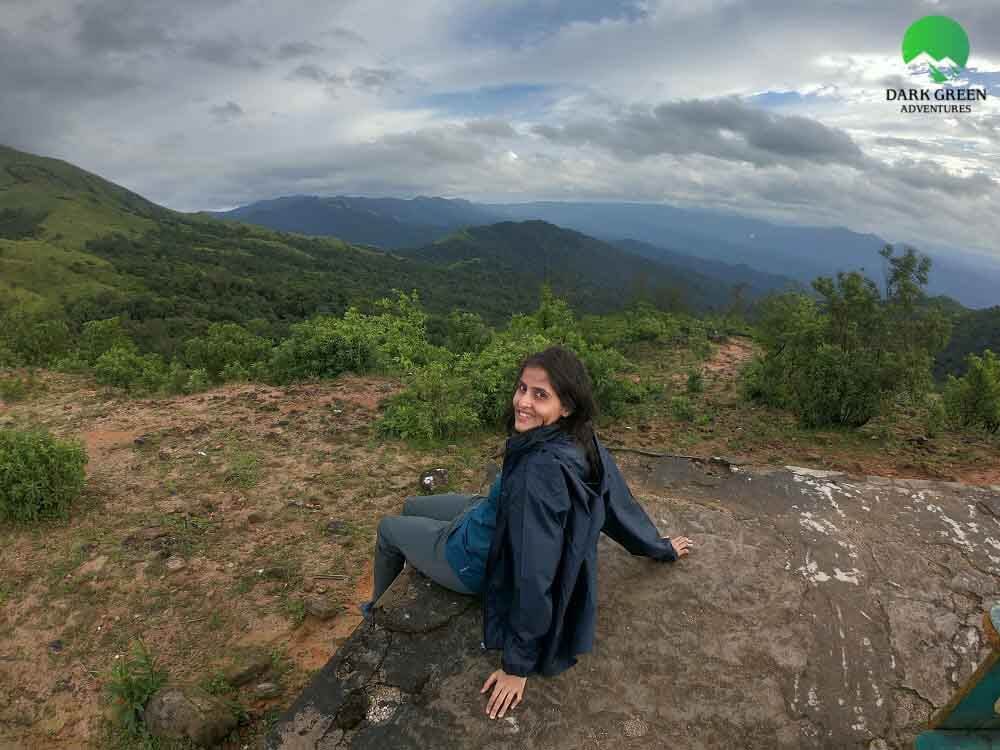The Western Ghats of Karnataka are a treasure trove for adventurers, nature lovers, trekkers, and solitude seekers. This UNESCO World Heritage region is not only renowned for its biodiversity but also for the numerous towering peaks that stand as guardians of pristine wilderness. Karnataka’s mountains aren’t just high—they’re deeply immersive experiences, offering rich forest trails, ancient temples, thundering waterfalls, wildlife sightings, and tranquil solitude. For those who enjoy trekking adventures, check out our Rann of Kutch Festival for a unique experience.
The terrain here combines rugged mountain ridges, shola forests, and panoramic valley views, offering a playground for serious trekkers and casual wanderers alike. You might also be interested in our Egypt or Cambodia trips, which also offer fantastic treks and experiences.
Why Trek the Mountains of Karnataka?
The Western Ghats in Karnataka are globally recognized as a biodiversity hotspot, housing numerous endemic plant and animal species. The terrain is rugged, the flora is lush and untouched, and the views—breathtaking. Here’s why Karnataka’s mountains are a trekker’s dream:
- Endless Greenery: No matter where you stand, your eyes meet rolling meadows, dense forests, and green hills stretching into the horizon.
- Hidden Waterfalls: Discover stunning waterfalls tucked deep within the forests—many unnamed and untouched.
- Solitude on Trails: Most of these treks are offbeat. On weekdays, it’s possible to have entire trails to yourself.
- Dark Forest Trails: Some paths remain shadowy and cool even during midday due to thick tree canopies.
- Pristine Sounds of Nature: With minimal foot traffic, the natural acoustics of birdcalls, rustling leaves, and insect buzz create an immersive experience.
- Permit-Only Access: Several treks require forest permits, maintaining ecological balance and limiting crowding.
- Leech Warning: Monsoon treks come with leech activity. Always wear leech socks or avoid rainy months.
- Best Seasons: Trekking is safest and most scenic post-monsoon (October to January) and during cool winters (February to March).
If you’re looking for other exciting trekking destinations, consider our Norway Northern Lights or Turkey tours, each offering unforgettable experiences.
List of the 10 Highest Mountains of Karnataka
Below is a deep-dive into Karnataka’s tallest mountains, enriched with geographical, cultural, and trekking insights to guide your next adventure.
1. Mullayanagiri Peak (1930m) – The Crown of Karnataka
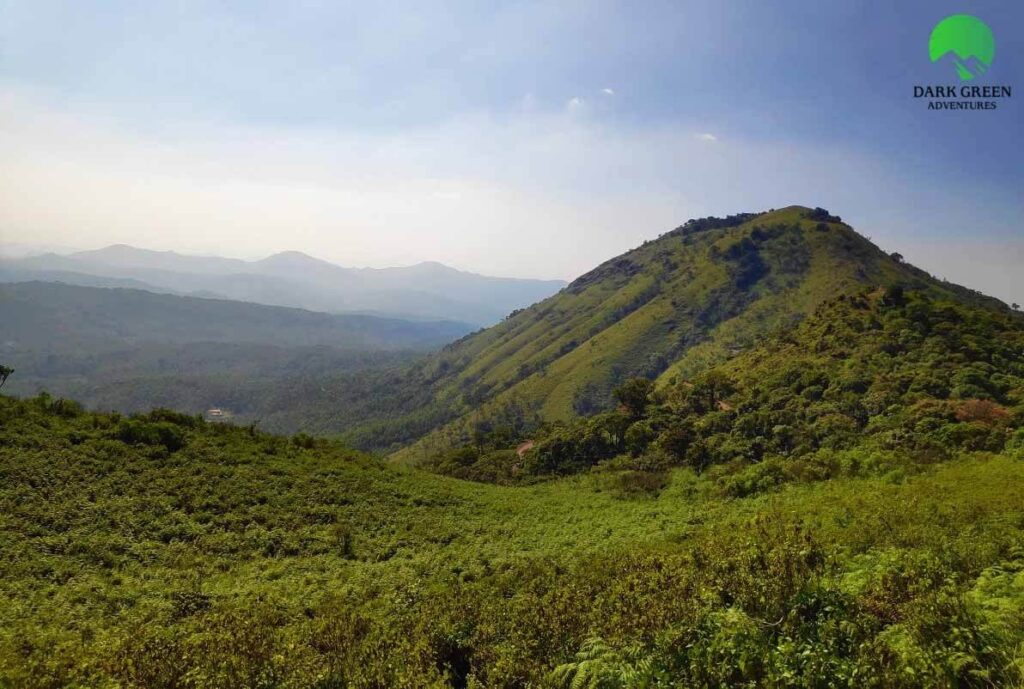
Located about 20 km from Chikkamagaluru, Mullayanagiri is not just the highest mountain in Karnataka—it’s a pilgrimage site for adventurers and spiritual seekers alike. Named after the revered Saint Mulappa Swamy, who is said to have meditated in caves here, the mountain is topped by a small temple dedicated to Lord Shiva.
What to Expect:
- A staircase with roughly 100 steps takes you to the summit from the parking area.
- An alternative and highly scenic trail, Sarpadari, begins near the Baba Budangiri Road and snakes through meadows and thick grasses.
- The caves below the summit, ancient yet accessible, add an aura of mystery.
This peak offers panoramic views of coffee estates, forests, and rolling valleys—a blend of sacred energy and scenic marvel.
2. Kudremukh (1894m) – The Horse-Faced Wonder
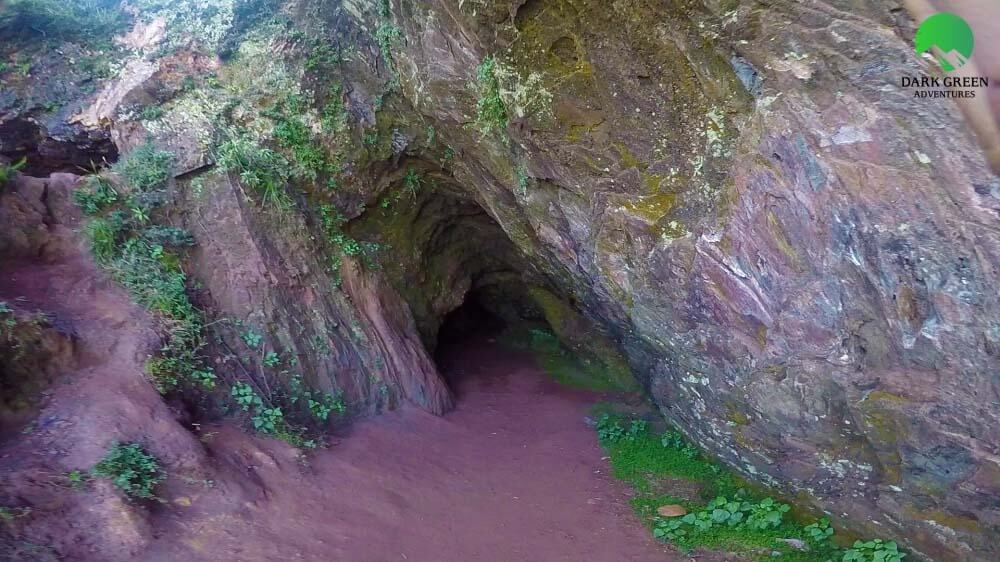
Kudremukh, which translates to “Horse Face,” is so named due to its distinct shape when viewed from a distance. Located inside Kudremukh National Park, this peak is famous for its undulating grasslands, dense forests, and incredible biodiversity. For a similarly scenic experience, explore our Mauritius holiday packages.
Key Trekking Info:
- Entry is capped at 50 people per day.
- Camping is not permitted; it’s a day trek covering 22 kilometers round trip.
- The trek begins after a 6km jeep ride from Samse, the base village.
- Expect to cross rivers, open meadows, and thick jungle corridors.
Known for its vast and cinematic landscapes, Kudremukh is a photographer’s paradise and a trekker’s challenge.
3. Kattari Betta (1800m) – Where Two Ghats Meet

The tallest peak in the BR Hills (Biligirirangana Hills), Kattari Betta is where Eastern and Western Ghats converge, creating a rare ecosystem that’s home to elephants, tigers, and hundreds of bird species.
What Makes It Unique:
- Historical association with Veerappan, the infamous forest outlaw.
- Part of Biligiri Ranganatha Swamy Temple Wildlife Sanctuary.
- Provides sweeping views of the Cauvery River Basin and surrounding wildlife corridors.
For trekkers looking to blend ecology, culture, and adventure, Kattari Betta delivers in abundance.
4. Tadiandamol (1748m) – The Broad Hill of Coorg
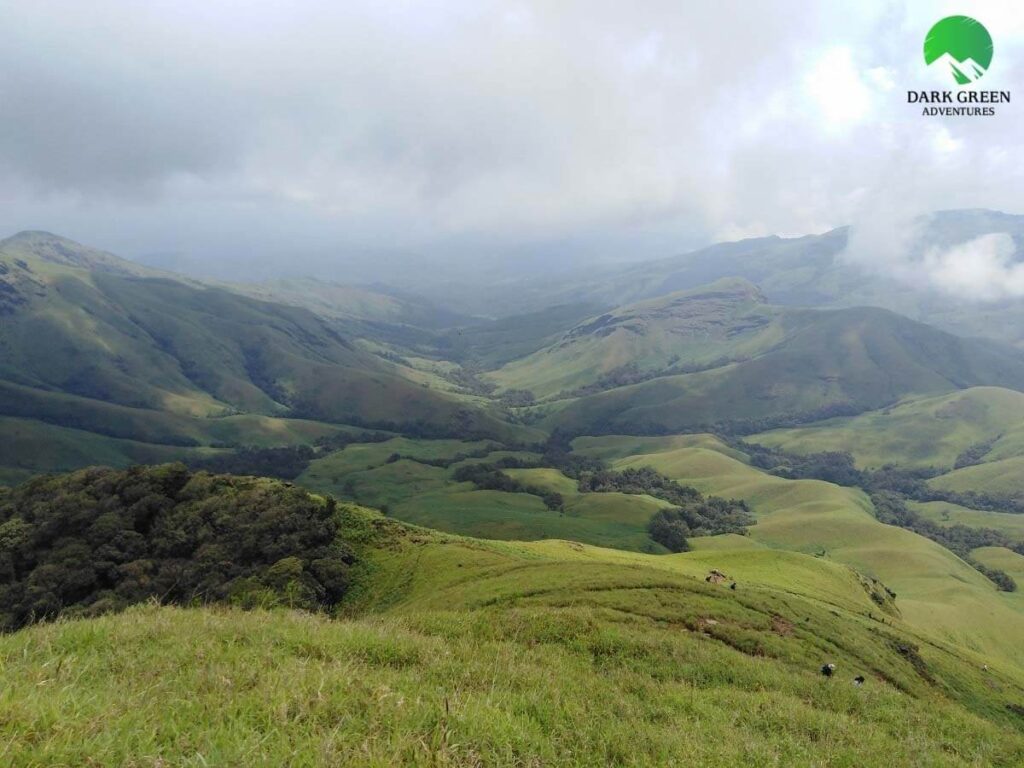
Situated 35 km from Madikeri, Tadiandamol is the highest point in the Kodagu district. The name means “broad hill” and reflects the wide base and expansive views offered by the summit.
Trek Essentials:
- Start your journey from Nalaknad Palace, a 200-year-old historical monument.
- The trail passes through shola forests, open ridges, and rocky patches.
- Camping is banned, but multiple homestays in Kakkabe village offer a comfortable stay.
Perfect for a day hike, it’s an excellent introduction to the wonders of the Western Ghats.
5. Kumara Parvata / Pushpagiri (1712m) – Karnataka’s Toughest Trail

Regarded as the most demanding trek in Karnataka, Kumara Parvata takes you through thick forests, steep ascents, and blissful grasslands.
Vital Info:
- Entry through Kukke Subramanya or Beedehalli (Pushpagiri side).
- Trek distance: 28+ km round trip.
- Overnight camping at Girigadde is essential.
- Carry your own food supplies; cooking is not allowed, and available food is basic.
Though grueling, the 360-degree view at the summit makes every step worth the effort.
6. Merthi Gudda (1676m) – The Secret of Basarikatte
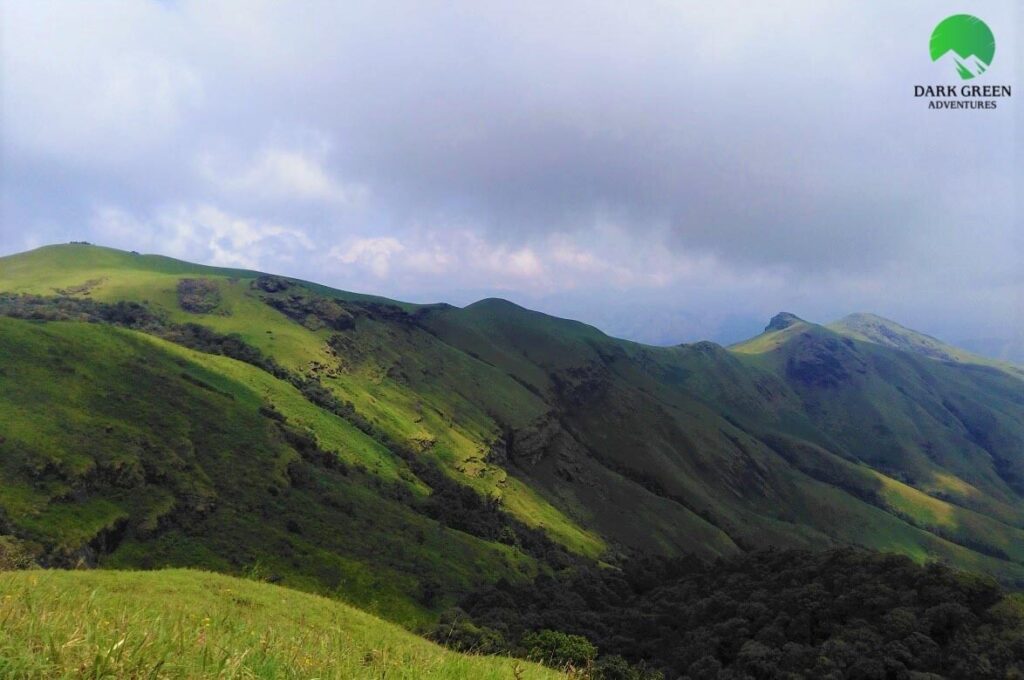
Far from the tourist radar, Merthi Gudda is perfect for those seeking undisturbed nature and solitude.
Why Trek Here:
- Begins from Basarikatte village, passing through tea estates.
- Offers hidden waterfalls, mist-covered trails, and breathtaking views of Kalasa valley.
- Shares its ecosystem with treks like Kudremukh and Ballalarayana Durg.
Ideal for experienced trekkers looking to explore lesser-known terrain.
7. Kotebetta (1620m) – The Fort-Shaped Peak of Coorg

Resembling a fort from a distance, Kotebetta is the third highest peak in Coorg and a local favorite.
Key Details:
- Trail starts from a junction on the Madikeri-Somvarpet highway.
- Passes through coffee plantations, small streams, and quaint villages.
- No permission required, making it beginner-friendly.
The presence of a Lord Shiva temple at the summit adds spiritual significance.
8. Brahmagiri (1608m) – Mythology Meets Nature

A border peak between Karnataka and Kerala, Brahmagiri is steeped in legends and biodiversity.
Must-Knows:
- Start the 9km trek from Iruppu Falls.
- Permission required from Srimangala Forest Office.
- Midway halt at Narimale Forest Guesthouse—ideal for an overnight stay.
- The final ascent is via pristine grasslands that stretch endlessly.
This is one of Karnataka’s most spiritually powerful and visually inspiring treks.
9. Gangamoola (1458m) – The Birthplace of Rivers

This sacred peak in the Kudremukh region is where three important rivers—Tunga, Bhadra, and Netravathi—originate.
Highlights:
- Also called Varaha Parvata, with temple ruins and deity carvings inside a cave.
- Dense, dark forests, often with fallen logs and tricky terrain.
- Requires permit and guide for navigation and safety.
Gangamoola is a mix of spiritual pilgrimage, environmental marvel, and jungle adventure.
10. Gopalaswamy Betta (1450m) – The Mist-Covered Sentinel of Bandipur

Rising above the Bandipur National Park, Himavad Gopalaswamy Betta is known for its fog-covered landscape, ancient temple, and abundant wildlife.
Important Notes:
- No private vehicles allowed; use the state-run bus from forest check post.
- Temple dedicated to Lord Krishna (Venugopalaswamy).
- Overnight stays are not allowed.
If you want to combine spiritual peace with forest serenity, this is your spot.
Why Trek in Karnataka?
From Shola forests to coffee plantations and breathtaking waterfalls, Karnataka offers a diverse trekking experience. Unlike more commercial trekking destinations, many trails here are still less-explored, giving adventurers a chance to connect with nature and local cultures in a raw, authentic way. The state is also accessible from major cities like Bangalore, Mangalore, and Mysore, making it ideal for weekend treks or longer expeditions.
Best Time to Visit These Mountains
To truly enjoy the serene vistas and avoid harsh weather conditions:
- Winter (Nov to Feb) is ideal for most treks with clear skies and cool weather.
- Monsoon (Jun to Sep) transforms these hills into lush green heavens, though some trails may be slippery and leech-prone.
- Summer (Mar to May) is best for higher altitude peaks like Mullayanagiri, where temperatures remain pleasant.
Ready to Conquer Karnataka’s Highest Peaks?
Whether you’re a seasoned trekker or a beginner wanting to explore Karnataka’s wild beauty, DarkGreen Adventures has meticulously curated treks to suit every skill level. With certified guides, all-inclusive itineraries, and a passion for nature, we ensure you experience these mountains like never before—with safety, community, and unforgettable memories. If you’re in the mood for a different kind of adventure, check out our Arunachal or Mauritius Tour Package Kesari.
Frequently Asked Question
Q1. Which is the highest peak in Karnataka?
Ans. Mullayanagiri, at 1930 meters above sea level, is the highest peak in Karnataka.
Q2. Do I need permission for trekking in Karnataka?
Ans. Yes, for many peaks like Kudremukh, Kumara Parvata, and Brahmagiri, you must obtain permits from the forest department.
Q3. What’s the best time to trek in Karnataka?
Ans. The ideal seasons are post-monsoon (October to December) and winter (January to February) for clear skies and safe trails.
Q4. Can beginners do these treks?
Yes! Peaks like Kotebetta and Tadiandamol are beginner-friendly, while Kudremukh and Kumara Parvata are for experienced trekkers.Ans. Yes! Peaks like Kotebetta and Tadiandamol are beginner-friendly, while Kudremukh and Kumara Parvata are for experienced trekkers.
Q5. Are camping and overnight stays allowed?
Ans. Camping is allowed at designated spots like Kumara Parvata’s Girigadde, but banned at Kudremukh and Tadiandamol due to conservation.
Q6. What kind of wildlife might I encounter?
Ans. You may come across elephants, bison, deer, monkeys, and leeches. Forest guides ensure safety protocols are followed.
Q7. How should I prepare for these treks?
Ans. Wear good trekking shoes, carry 2L water, light snacks, a first-aid kit, a rain jacket (during monsoon), and valid ID for permits.
Q8. Why choose DarkGreen Adventures for mountain treks?
Ans. We provide guided treks, travel arrangements, forest permissions, local insights, and a welcoming community for all adventure lovers.

